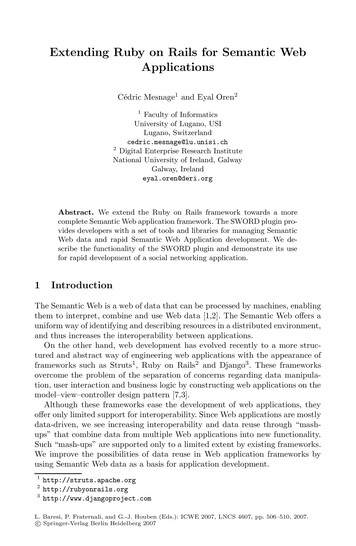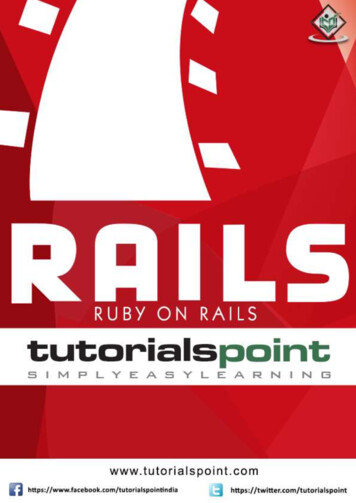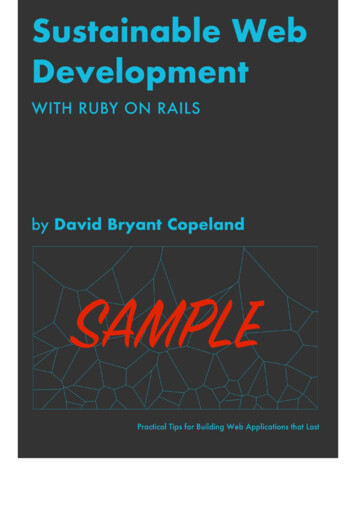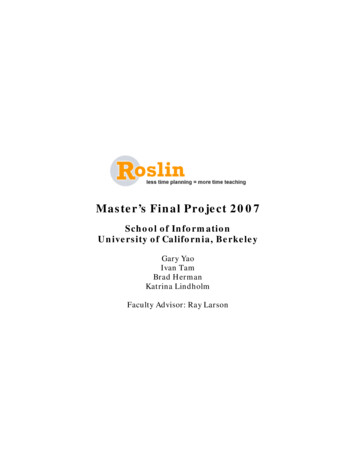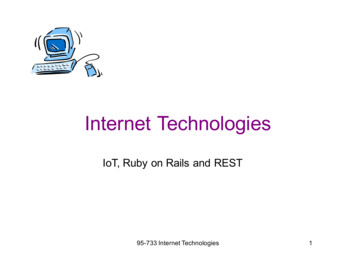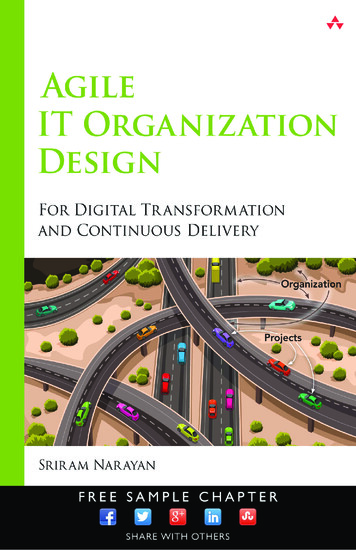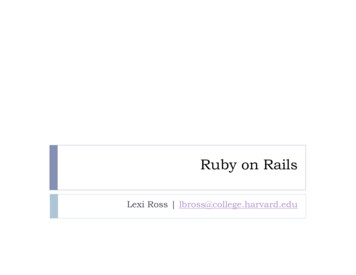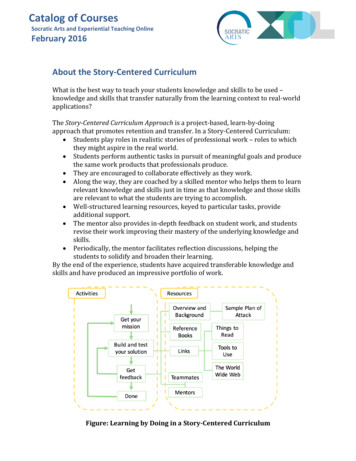
Transcription
Important InformationAbout Rails VersionsThis book is written for Rails 3.The Rails core team is continuing to work on Rails. From time to time, newreleases may introduce incompatibilities for applications written for priorversions of Rails, including the code in this book.To run the examples provided in this book, it is important that you installthe correct version of Rails, as described in Chapter 1, Installing Rails, onpage 24To determine the version of Rails that you are running, you can issue rails -vat a command prompt.Information on changes to Rails that affect this book can be found at Sam, Dave, and David
When I started learning Ruby on Rails, I read the first edition of this book.Its holistic view of the Rails framework and community provides any newdeveloper the kick start they need to a highly successful career. After readingthrough the latest edition cover to cover, I can happily say that it continuesthat trend and remains the first book I recommend to any new Rails developer.Mikel LindsaarRails core commit team, creator of the Ruby Mail library, anddirector, RubyXAgile Web Development with Rails does an excellent job of making the Railsenvironment accessible in an enjoyable and memorable way. In addition, thisbook is the first I’ve seen that provides a sensible and coherent explanationof the MVC pattern, and it does so in a natural progression using examplesthat completely remove any mystery.Ken CoarAuthor, open software evangelist, and Apache developerAgile Web Development with Rails successfully straddles a fine line betweenbeing a fun-to-read introduction to Rails (and Ruby) and a straightforwardguide to some advanced features of the platform, nicely supplanting the everchanging online documentation.Glen DanielsIndependent technologist and consultantI’ve never read a programming book as successful as Agile Web Developmentwith Rails. Sam made learning Ruby on Rails easy, comprehensive, and fun.Keith BallingerChairman of WS-I’s first Basic Profile working group; author; andkey contributor to the .NET and Visual Studio .NET frameworks
Agile Web Development with RailsFourth EditionSam RubyDave ThomasDavid Heinemeier HanssonLeon BreedtMike ClarkJames Duncan DavidsonJustin GehtlandAndreas SchwarzwithThe Pragmatic BookshelfRaleigh, North CarolinaDallas, Texas
Many of the designations used by manufacturers and sellers to distinguish their products areclaimed as trademarks. Where those designations appear in this book, and The Pragmatic Programmers, LLC was aware of a trademark claim, the designations have been printed in initial capitalletters or in all capitals. The Pragmatic Starter Kit, The Pragmatic Programmer, Pragmatic Programming, Pragmatic Bookshelf and the linking g device are trademarks of The Pragmatic Programmers,LLC.Every precaution was taken in the preparation of this book. However, the publisher assumes noresponsibility for errors or omissions, or for damages that may result from the use of information(including program listings) contained herein.Our Pragmatic courses, workshops, and other products can help you and your team create bettersoftware and have more fun. For more information, as well as the latest Pragmatic titles, pleasevisit us at http://www.pragprog.com.Copyright 2011 The Pragmatic Programmers LLC.All rights reserved.No part of this publication may be reproduced, stored in a retrieval system, or transmitted, in anyform, or by any means, electronic, mechanical, photocopying, recording, or otherwise, without theprior consent of the publisher.Printed in the United States of America.ISBN-10: 1-934356-54-9ISBN-13: 978-1-934356-54-8Printed on acid-free paper.P1.0 printing, March 2011Version: 2011-3-29
ContentsPreface to the Fourth Edition12Acknowledgments14IntroductionRails Simply Feels Right .Rails Is Agile . . . . . . .Who This Book Is For . .How To Read This Book .1616181919.Part I—Getting Started12323Installing Rails1.1Installing on Windows . . . . . . . . . . . . .1.2Installing on Mac OS X . . . . . . . . . . . .1.3Installing on Linux . . . . . . . . . . . . . . .1.4Choosing a Rails Version . . . . . . . . . . .1.5Setting Up Your Development Environment1.6Rails and Databases . . . . . . . . . . . . . .1.7What We Just Did . . . . . . . . . . . . . . .2424262728293334Instant Gratification2.1Creating a New Application2.2Hello, Rails! . . . . . . . . .2.3Linking Pages Together . .2.4What We Just Did . . . . .3535374447The Architecture of Rails Applications3.1Models, Views, and Controllers . . . . . . . . . . . . . . . .3.2Rails Model Support . . . . . . . . . . . . . . . . . . . . . . .3.3Action Pack: The View and Controller . . . . . . . . . . . .48485153.
CONTENTS4Introduction to Ruby4.1Ruby Is an Object-Oriented Language4.2Data Types . . . . . . . . . . . . . . . .4.3Logic . . . . . . . . . . . . . . . . . . . .4.4Organizing Structures . . . . . . . . . .4.5Marshaling Objects . . . . . . . . . . .4.6Pulling It All Together . . . . . . . . . .4.7Ruby Idioms . . . . . . . . . . . . . . .5555576063666667Part II—Building an Application705The Depot Application5.1Incremental Development . . . . . . . . . . . . . . . . . . . .5.2What Depot Does . . . . . . . . . . . . . . . . . . . . . . . . .5.3Let’s Code . . . . . . . . . . . . . . . . . . . . . . . . . . . . .717172766Task A: Creating the Application6.1Iteration A1: Creating the Products Maintenance Application . . . . . . . . . . . . . . . . . . . . . . . . . . . . . . . . .6.2Iteration A2: Making Prettier Listings . . . . . . . . . . . . .777Task B: Validation and Unit Testing7.1Iteration B1: Validating! . . . . . . . . . . . . . . . . . . . . .7.2Iteration B2: Unit Testing of Models . . . . . . . . . . . . .9090958Task8.18.28.38.4C: Catalog DisplayIteration C1: Creating the Catalog Listing . . . .Iteration C2: Adding a Page Layout . . . . . . . .Iteration C3: Using a Helper to Format the PriceIteration C4: Functional Testing of Controllers .1051051081121139Task9.19.29.3D: Cart CreationIteration D1: Finding a Cart . . . . . . . . . . . . . . . . . .Iteration D2: Connecting Products to Carts . . . . . . . . .Iteration D3: Adding a Button . . . . . . . . . . . . . . . . .11711711812010Task10.110.210.3E: A Smarter CartIteration E1: Creating a Smarter Cart . . . . . . . . . . . .Iteration E2: Handling Errors . . . . . . . . . . . . . . . . .Iteration E3: Finishing the Cart . . . . . . . . . . . . . . . .126126131134.7783Report erratumthis copy is (P1.0 printing, March 2011)8
CONTENTS11Task11.111.211.311.411.5F: Add a Dash of AjaxIteration F1: Moving the Cart . . . . . . .Iteration F2: Creating an Ajax-Based CartIteration F3: Highlighting Changes . . . .Iteration F4: Hiding an Empty Cart . . . .Testing Ajax Changes . . . . . . . . . . . .13914014514815015412Task12.112.212.3G: Check Out!Iteration G1: Capturing an Order . . . . . . . . . . . . . . .Iteration G2: Atom Feeds . . . . . . . . . . . . . . . . . . . .Iteration G3: Pagination . . . . . . . . . . . . . . . . . . . . .15815817217613Task H: Sending Mail13.1 Iteration H1: Sending Confirmation Emails . . . . . . . . .13.2 Iteration H2: Integration Testing of Applications . . . . . .18118118814Task14.114.214.314.4I: Logging InIteration I1: Adding Users . . . . . . . . . . . . . . .Iteration I2: Authenticating Users . . . . . . . . . . .Iteration I3: Limiting Access . . . . . . . . . . . . . .Iteration I4: Adding a Sidebar, More J: InternationalizationIteration J1: Selecting the Locale . . . .Iteration J2: Translating the StorefrontIteration J3: Translating Checkout . . .Iteration J4: Add a Locale Switcher . . .21621721922623216Task16.116.216.3K: Deployment and ProductionIteration K1: Deploying with Phusion Passenger and MySQLIteration K2: Deploying Remotely with Capistrano . . . . .Iteration K3: Checking Up on a Deployed Application . . .17Depot Retrospective17.1 Rails Concepts . . . . . . . . . . . . . . . . . . . . . . . . . .17.2 Documenting What We Have Done . . . . . . . . . . . . . .15.235237242248252252256Report erratumthis copy is (P1.0 printing, March 2011)9
CONTENTSPart III—Rails in Depth25718Finding Your Way Around Rails18.1 Where Things Go . . . . . . . . . . . . . . . . . . . . . . . . .18.2 Naming Conventions . . . . . . . . . . . . . . . . . . . . . .25825826719Active Record19.1 Defining Your Data . . . . . . . . . . . . . . . . . . .19.2 Locating and Traversing Records . . . . . . . . . . .19.3 Creating, Reading, Updating, and Deleting (CRUD)19.4 Participating in the Monitoring Process . . . . . . .19.5 Transactions . . . . . . . . . . . . . . . . . . . . . . .27127127627929530220Action Dispatch and Action Controller20.1 Dispatching Requests to Controllers . . . . . . . . . . . . .20.2 Processing of Requests . . . . . . . . . . . . . . . . . . . . .20.3 Objects and Operations That Span Requests . . . . . . . .30730731832921Action View21.1 Using Templates . . . . . . . . . . . . . . . . . . . .21.2 Generating Forms . . . . . . . . . . . . . . . . . . .21.3 Processing Forms . . . . . . . . . . . . . . . . . . .21.4 Uploading Files to Rails Applications . . . . . . . .21.5 Using Helpers . . . . . . . . . . . . . . . . . . . . . .21.6 Reducing Maintenance with Layouts and Partials.33933934134434534935522Caching22.1 Page Caching . . . . . . . . . . . . . . . . . . . . . . . . . . .22.2 Expiring Pages . . . . . . . . . . . . . . . . . . . . . . . . . .22.3 Fragment Caching . . . . . . . . . . . . . . . . . . . . . . . .36436436737323Migrations23.1 Creating and Running Migrations . . . . .23.2 Anatomy of a Migration . . . . . . . . . . .23.3 Managing Tables . . . . . . . . . . . . . . .23.4 Advanced Migrations . . . . . . . . . . . .23.5 When Migrations Go Bad . . . . . . . . . .23.6 Schema Manipulation Outside Migrations.379379382386390394395Nonbrowser Applications24.1 A Stand-Alone Application Using Active Record . . . . . . .24.2 A Library Function Using Active Support . . . . . . . . . .24.3 A Remote Application Using Active Resource . . . . . . . .39639639740224.Report erratumthis copy is (P1.0 printing, March 2011)10
enciesGenerating XML with Builder . . . . . . . .Generating HTML with ERb . . . . . . . . .Managing Dependencies with Bundler . . .Interfacing with the Web Server with Rack .Automating Tasks with Rake . . . . . . . . .Survey of Rails’ Dependencies . . . . . . . ginsCredit Card Processing with Active MerchantSaving Bandwidth with Asset Packager . . .Beautifying Our Markup with Haml . . . . . .Write Less and Do More with JQuery . . . . .Finding More at RailsPlugins.org . . . . . . .42342342542743043227Where to Go from Here435ABibliography437Index438Report erratumthis copy is (P1.0 printing, March 2011)11
Preface to the Fourth EditionWhen Dave asked me to join as a coauthor of the third edition of this book,I was thrilled. After all, it was from the first printing of the first edition ofthis book that I had learned Rails. Dave and I also have much in common.Although he prefers Emacs and Mac OS X and my preferences tend toward Vimand Ubuntu, we both share a love for the command line and getting our fingers dirty with code—starting with tangible examples before diving into heavytheory.Since the time the third edition was published (and, in fact, since the first,second, and third editions), much has changed. Rails is in the process ofbeing significantly refactored, mostly internally. A number of features thatwere used in previous examples have been initially deprecated and subsequently removed. New features have been added, and much experience hasbeen obtained as to what the best practices are for using Rails. Rails now alsoworks on Ruby 1.9, and each of the examples has been tested with Ruby 1.8.7and Ruby 1.9.2.Additionally, Rails has exploded from being a popular framework to an activeand vibrant ecosystem, complete with many popular plugins and deep integration into third-party tools. In the process, Rails has become mainstream,attracting a more diverse set of developers to the framework.This has led to a reorganization of the book. Many newcomers to Rails havenot had the pleasure of being introduced to Ruby, so this section has beenpromoted from an appendix to a chapter in Part I. We follow Part I with a stepby-step walk-through of building a real application, which has been updatedand streamlined to focus on current best practices.But the biggest change is in the final part: because it is no longer practical tocover the entire ecosystem of Rails given both its breadth and rate of change,this part is now focused on providing an overall perspective of the landscape,
P REFACETO THEF OUR TH E DITIONenabling you, the reader, to know what to look for and where to find plugins and related tools to address common needs that go far beyond what theframework itself contains.In short, this book needed to adapt. Once again.Sam RubyMarch 2011Report erratumthis copy is (P1.0 printing, March 2011)13
AcknowledgmentsYou’d think that producing a new edition of a book would be easy. After all,you already have all the text. It’s just a tweak to some code here and a minorwording change there, and you’re done. You’d think.It’s difficult to tell exactly, but our impression is that creating each editionof Agile Web Development with Rails took about as much effort as the firstedition. Rails is constantly evolving and, as it does, so has this book. Partsof the Depot application were rewritten several times, and all of the narrativewas updated. The emphasis on REST and the avoidance of features as theybecome deprecated have repeatedly changed the structure of the book as whatwas once hot became just lukewarm.So, this book would not exist without a massive amount of help from the Rubyand Rails communities. To start with, we had a number of incredibly helpfulformal reviewers of drafts of this book:Jeremy Anderson, Ken Coar, Jeff Cohen, Joel Clermont, Geoff Drake,Pavan Gorakavi, Michael Jurewitz, Mikel Lindsaar, Paul Rayner,Martijn Reuvers, Doug Rhoten, Gary Sherman, Davanum Srinivas,Stefan Turalski, and José ValimAdditionally, each edition of this book has been released as a beta book: earlyversions were posted as PDFs, and people made comments online. And comment they did: more than 800 suggestions and bug reports were posted forthis edition alone. The vast majority ended up being incorporated, making thisbook immeasurably more useful than it would have been. While thanks goout to all for supporting the beta book program and for contributing so muchvaluable feedback, a number of contributors went well beyond the call of duty:Manuel E. Vidaurre Arenas, Seth Arnold, Will Bowlin, Andy Brice,Jason Catena, Victor Marius Costan, David Hadley, Jason Holloway,David Kapp, Trung LE, Kristian Riiber Mandrup, mltsy,Steve Nicholson, Jim Puls, Johnathan Ritzi, Leonel S, Kim Shrier,Don Smith, Joe Straitiff, and Martin Zoller
A CKNOWLEDGMENTSFinally, the Rails core team has been incredibly helpful, answering questions,checking out code fragments, and fixing bugs. A big “thank you” to the following:Scott Barron (htonl), Jamis Buck (minam), Thomas Fuchs (madrobby),Jeremy Kemper (bitsweat), Yehuda Katz (wycats),Michael Koziarski (nzkoz), Marcel Molina Jr, (noradio),Rick Olson (technoweenie), Nicholas Seckar (Ulysses),Sam Stephenson (sam), Tobias Lütke (xal), José Valim (josevalim), andFlorian Weber (csshsh)Sam RubyMarch 2011rubys@intertwingly.netReport erratumthis copy is (P1.0 printing, March 2011)15
IntroductionRuby on Rails is a framework that makes it easier to develop, deploy, andmaintain web applications. During the months that followed its initial release,Rails went from being an unknown toy to being a worldwide phenomenon, andmore important, it has become the framework of choice for the implementationof a wide range of so-called Web 2.0 applications.Why is that?Rails Simply Feels RightFirst, a large number of developers were frustrated with the technologies theywere using to create web applications. It didn’t seem to matter whether theywere using Java, PHP, or .NET—there was a growing sense that their job wasjust too damn hard. And then, suddenly, along came Rails, and Rails waseasier.But easy on its own doesn’t cut it. We’re talking about professional developerswriting real-world websites. They wanted to feel that the applications theywere developing would stand the test of time—that they were designed andimplemented using modern, professional techniques. So, these developers duginto Rails and discovered it wasn’t just a tool for hacking out sites.For example, all Rails applications are implemented using the Model-ViewController (MVC) architecture. Java developers are used to frameworks suchas Tapestry and Struts, which are based on MVC. But Rails takes MVC further:when you develop in Rails, you start with a working application, there’s aplace for each piece of code, and all the pieces of your application interact in astandard way.Professional programmers write tests. And again, Rails delivers. All Rails applications have testing support baked right in. As you add functionality to thecode, Rails automatically creates test stubs for that functionality. The framework makes it easy to test applications, and as a result, Rails applicationstend to get tested.
R AILS S IMPLY F EELS R IGHTRails applications are written in Ruby, a modern, object-oriented scriptinglanguage. Ruby is concise without being unintelligibly terse—you can expressideas naturally and cleanly in Ruby code. This leads to programs that are easyto write and (just as important) are easy to read months later.Rails takes Ruby to the limit, extending it in novel ways that make a programmer’s life easier. This makes our programs shorter and more readable.It also allows us to perform tasks that would normally be done in externalconfiguration files inside the codebase instead. This makes it far easier to seewhat’s happening. The following code defines the model class for a project.Don’t worry about the details for now. Instead, just think about how muchinformation is being expressed in a few lines of code.class Project ActiveRecord::Basebelongs to :portfoliohas one:project managerhas many:milestoneshas many:deliverables, :through :milestonesvalidatesvalidatesvalidatesend:name, :description, :presence true:non disclosure agreement, :acceptance true:short name, :uniqueness trueTwo other philosophical underpinnings keep Rails code short and readable:DRY and convention over configuration. DRY stands for don’t repeat yourself :every piece of knowledge in a system should be expressed in just one place.Rails uses the power of Ruby to bring that to life. You’ll find very little duplication in a Rails application; you say what you need to say in one place—a placeoften suggested by the conventions of the MVC architecture—and then moveon. For programmers used to other web frameworks, where a simple changeto the schema could involve them in half a dozen or more code changes, thiswas a revelation.Convention over configuration is crucial, too. It means that Rails has sensible defaults for just about every aspect of knitting together your application.Follow the conventions, and you can write a Rails application using less codethan a typical Java web application uses in XML configuration. If you need tooverride the conventions, Rails makes that easy, too.Developers coming to Rails found something else, too. Rails isn’t playing catchup with the new de facto web standards; it’s helping define them. And Railsmakes it easy for developers to integrate features such as Ajax and RESTfulinterfaces into their code, because support is built in. (And if you’re not familiar with Ajax and REST interfaces, never fear—we’ll explain them later in thebook.)Report erratumthis copy is (P1.0 printing, March 2011)17
R AILS I S A GILEDevelopers are worried about deployment too. They found that with Rails youcan deploy successive releases of your application to any number of serverswith a single command (and roll them back equally easily should the releaseprove to be somewhat less than perfect).Rails was extracted from a real-world, commercial application. It turns outthat the best way to create a framework is to find the central themes in aspecific application and then bottle them up in a generic foundation of code.When you’re developing your Rails application, you’re starting with half of areally good application already in place.But there’s something else to Rails—something that’s hard to describe. Somehow, it just feels right. Of course, you’ll have to take our word for that untilyou write some Rails applications for yourself (which should be in the nextforty-five minutes or so.). That’s what this book is all about.Rails Is AgileThe title of this book is Agile Web Development with Rails. You may be surprised to discover that we don’t have explicit sections on applying agile practices X, Y, and Z to Rails coding.The reason is both simple and subtle. Agility is part of the fabric of Rails.Let’s look at the values expressed in the Agile Manifesto as a set of four preferences:1 Individuals and interactions over processes and tools Working software over comprehensive documentation Customer collaboration over contract negotiation Responding to change over following a planRails is all about individuals and interactions. There are no heavy toolsets,no complex configurations, and no elaborate processes. There are just smallgroups of developers, their favorite editors, and chunks of Ruby code. Thisleads to transparency; what the developers do is reflected immediately in whatthe customer sees. It’s an intrinsically interactive process.Rails doesn’t denounce documentation. Rails makes it trivially easy to create HTML documentation for your entire codebase. But the Rails developmentprocess isn’t driven by documents. You won’t find 500-page specifications atthe heart of a Rails project. Instead, you’ll find a group of users and developers jointly exploring their need and the possible ways of answering thatneed. You’ll find solutions that change as both the developers and the usersbecome more experienced with the problems they’re trying to solve. You’ll find1. http://agilemanifesto.org/. Dave Thomas was one of the seventeen authors of this document.Report erratumthis copy is (P1.0 printing, March 2011)18
W HO T HIS B OOK I S F ORa framework that delivers working software early in the development cycle.This software may be rough around the edges, but it lets the users start to geta glimpse of what you’ll be delivering.In this way, Rails encourages customer collaboration. When customers seejust how quickly a Rails project can respond to change, they start to trustthat the team can deliver what’s required, not just what has been requested.Confrontations are replaced by “What if?” sessions.That’s all tied to the idea of being able to respond to change. The strong, almostobsessive, way that Rails honors the DRY principle means that changes toRails applications impact a lot less code than the same changes would in otherframeworks. And since Rails applications are written in Ruby, where conceptscan be expressed accurately and concisely, changes tend to be localized andeasy to write. The deep emphasis on both unit and functional testing, alongwith support for test fixtures and stubs during testing, gives developers thesafety net they need when making those changes. With a good set of tests inplace, changes are less nerve-racking.Rather than constantly trying to tie Rails processes to the agile principles,we’ve decided to let the framework speak for itself. As you read through thetutorial chapters, try to imagine yourself developing web applications this way:working alongside your customers and jointly determining priorities and solutions to problems. Then, as you read the more advanced concepts that followin Part III, see how the underlying structure of Rails can enable you to meetyour customers’ needs faster and with less ceremony.One last point about agility and Rails: although it’s probably unprofessionalto mention this, think how much fun the coding will be.Who This Book Is ForThis book is for programmers looking to build and deploy web-based applications. This includes application programmers who are new to Rails (and perhaps even new to Ruby) and ones who are familiar with the basics but want amore in-depth understanding of Rails.We presume some familiarity with HTML, Cascading Style Sheets (CSS), andJavaScript, in other words, the ability to view source on web pages. You do notneed to be an expert on these subjects; the most you will ever be expected to dois to copy and paste material from the book, all of which can be downloaded.How To Read This BookThe first part of this book makes sure you are ready. By the time you are donewith it, you will have been introduced to Ruby (the language), you will haveReport erratumthis copy is (P1.0 printing, March 2011)19
H OW T O R EAD T HIS B OOKbeen exposed to an overview of Rails itself, you will have both Ruby and Railsinstalled, and you will have verified this installation with a simple example.The next part takes you through the concepts behind Rails via an extendedexample; we build a simple online store. It doesn’t take you one by one througheach component of Rails (“here is a chapter on models, here is a chapter onviews,” and so forth). These components are designed to work together, andeach chapter in this section tackles a specific set of related tasks that involvea number of these components working together.Most folks seem to enjoy building the application along with the book. If youdon’t want to do all that typing, you can cheat and download the source code(a compressed tar archive or a zip file).2The third part of the book, starting on page 258, surveys the entire Railsecosystem. This starts with the functions and facilities of Rails that you willnow be familiar with. It then covers a number of key dependencies that theRails framework makes use of that contribute directly to the overall functionality that the Rails framework delivers. Finally, there is a survey of a numberof popular plugins that augment the Rails framework and make Rails an openecosystem rather than merely a framework.Along the way, you’ll see various conventions we’ve adopted.Live CodeMost of the code snippets we show come from full-length, running examples that you can download. To help you find your way, if a code listingcan be found in the download, there’ll be a bar before the snippet (justlike the one here).Download work/demo1/app/controllers/say controller.rbclass SayController ApplicationControllerdef helloenddef goodbyeendendThis contains the path to the code within the download. If you’re readingthe ebook version of this book and your ebook viewer supports hyperlinks, you can click the bar, and the code should appear in a browserwindow. Some browsers (such as Safari) will mistakenly try to interpretsome of the templates as HTML. If this happens, view the source of thepage to see the real source code.2. http://pragprog.com/titles/rails4/source code has the links for the downloads.Report erratumthis copy is (P1.0 printing, March 2011)20
H OW T O R EAD T HIS B OOKAnd in some cases involving the modification of an existing file where thelines to be changed may not be immediately obvious, you will also seesome helpful little triangles on the left of the lines that you will need tochange. Two such lines are indicated in the previous code.Ruby TipsAlthough you need to know Ruby to write Rails applications, we realizethat many folks reading this book will be learning both Ruby and Railsat the same time. You will find a (very) brief introduction to the Rubylanguage in Chapter 4, Introduction to Ruby, on page 55. When we use aRuby-specific construct for the first time, we’ll cross-reference it to thatchapter. For example, this paragraph contains a gratuitous use of :name,a Ruby symbol. In the margin, you’ll see an indication that symbols areexplained on page 56.:name֒ page 56David Says.Every now and then you’ll come across a David Says. sidebar. Here’swhere David Heinemeier Hansson gives you the real scoop on some particular aspect of Rails—rationales, tricks, recommendations, and more.Because he’s the fellow who invented Rails, these are the sections to readif you want to become a Rails pro.Joe Asks.Joe, the mythical developer, sometimes pops up to ask questions aboutstuff we talk about in the text. We answer these questions as we go along.This book isn’t meant to be a reference manual for Rails. Our experience is thatreference manuals are not the way most people learn. Instead, we show mostof the modules and many of their methods, either by example or narrativelyin the text, in the context of how these components are used and how they fittogether.Nor do we have hundreds of pages of API listings. There’s a good reason forthis—you get that documentation whenever you install Rails, and it’s guaranteed to be more up-to-date than the material in this book. If you install Railsusing RubyGems (which we recommend), simply st
Agile Web Development with Rails does an excellent job of making the Rails environment accessible in an enjoyable and memorable way. In addition, this book is the first I’ve seen that provides a sensible and coherent explanation of the MVC patter
